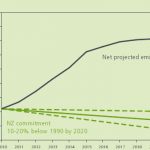This guest post by Professor Euan Mason of the University of Canterbury’s School of Forestry first appeared at his Photosynthesis blog. His analysis of the NZ and global position, and assessment of the potential forestry response is so interesting that I asked his permission to repost it here.
New Zealand’s initial attempt to mitigate the problem of climate change is moribund, so why is this? The Kyoto Protocol, which we ratified in 1997, bound us to keep our net emissions at 1990 gross emission levels between 2008 and 2012, but also tied us to particular patterns of thinking about greenhouse gases. Not all of these patterns are rational, nor are they all helpful. Nonetheless, with a rather unique emissions profile for a “first world” nation, we could offer the world valuable solutions for developing nations if only we would accept the opportunity. Forestry could easily make us fully greenhouse gas neutral while solving erosion problems and improving profitability of our hill country farms, but for this we need a rational approach to emissions trading and commitment from our populace.
In this article I shall outline some of the key modes of thinking introduced by the Kyoto Protocol; highlight where we are going wrong with emissions trading; and show how forestry could be at the heart of solutions to this global problem.
Continue reading “Why NZ’s Emissions Trading Scheme is failing and how we could fix it”


 There’s a huge gap between the emissions reductions the New Zealand government says it wants to achieve, and what its current emissions trading scheme settings will deliver, according to modelling by the Ministry for the Environment. In this week’s post at The Daily Blog —
There’s a huge gap between the emissions reductions the New Zealand government says it wants to achieve, and what its current emissions trading scheme settings will deliver, according to modelling by the Ministry for the Environment. In this week’s post at The Daily Blog — 

You must be logged in to post a comment.